
Orchard Floor Management Through Chemical Mowing
Here is a guest post from Benton County agent Ryan Neal, sharing the results of a chemical mowing demo performed in blueberries!
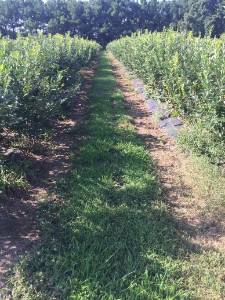
Grass strip just before spraying
There are times in a person’s life when they want the grass to grow and times we wish it would just stop.
In the row middles of a perennial crop, a grass strip can serve to prevent erosion and provide a nice walkway for pickers. Chemical mowing aims to provide the best of both worlds by maintaining a grass strip while reducing mowing.
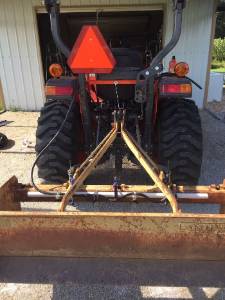

4 nozzle boom inside box blade (top); testing on driveway to insure uniform coverage (bottom)
Grass herbicides such as Select Max and Poast can easily be used among broadleaves like blueberries without fear of damaging the crop. These products generally require multiple, full rate applications to kill perennial grasses like Bermuda grass. The goal was to reduce the grass growth but keep the strip green for appearance purposes. The grass strip between rows was mowed on August 7th and Select Max was sprayed at the ½, ¾, and full rates on every other row.
Select Max costs $.75 per oz. so at the ¾ rate would cost $9/acre. This product has a 2 week PHI in blueberries. The Poast label has a section on orchard floor management which recommends not spraying during bloom or less than 3 days after mowing.

25 gallon sprayer inside front end loader
For this demo a simple boom was attached to the inside of a box blade and a 25 gallon sprayer was placed in the bucket of the tractor. The box blade was chosen because most farms will have this attachment and it does minimize drift by blocking off on 3 sides. This would be particularly useful if a non-selective product like glyphosate is used.
Half Rate (untreated side had to be mowed on week 4)
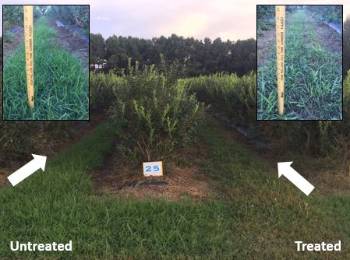
August 21st, 2019 (1 week after spraying)
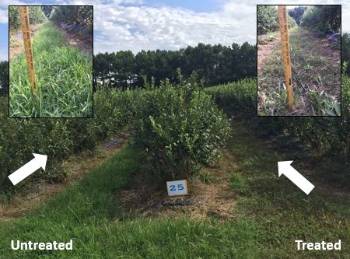
August 28th, 2019 (2 weeks after spraying)

September 4th, 2019 (3 weeks after spraying)
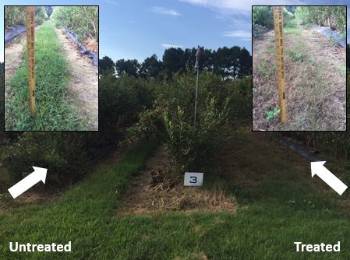
September 11th, 2019 (4 weeks after spraying)
3/4 Rate (Untreated side had to be mowed on week 4)
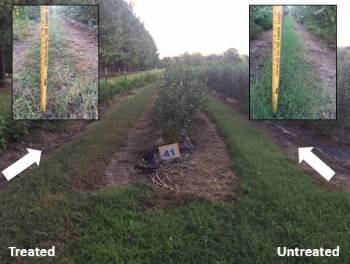
August 21st, 2019 (1 week after spraying)

August 28th, 2019 (2 weeks after spraying)

September 4th, 2019 (3 weeks after spraying)
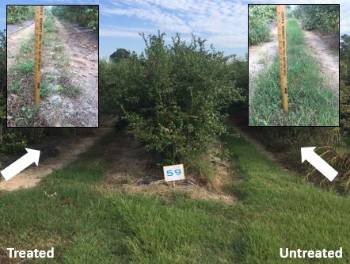
September 11th, 2019 (4 weeks after spraying)
Full Rate (Untreated side had to be mowed on week 4)
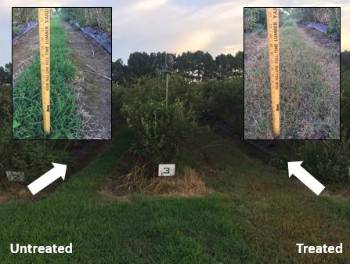
August 21st, 2019 (1 week after spraying)
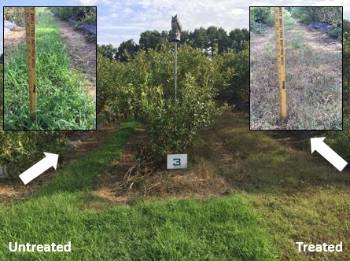
August 28th, 2019 (2 weeks after spraying)

September 4th, 2019 (3 weeks after spraying)

September 11th, 2019 (4 weeks after spraying)
Ultimately all treated middles had reduced grass growth. The ½ and ¾ rate treatments kept the grass greener while the full rate treatment was browner than I would have liked and probably killed some annual grass completely. The treated areas did not have to be mowed for about 5 weeks while the untreated middles would have had to be mowed 2-3 times. Considering the cost of product, setup time, and the extra trip through the field to spray, the savings are not too significant.
Where I see the best use of this technique would be to spray two weeks before harvest and possibly eliminate the need to mow during harvest. This would save time during the busy season but also eliminate knocking off fruit from the bush while mowing. It is important to note that if there is a lot of broadleaves or sedges in the middles this product would have no effect and another product would need to be used.